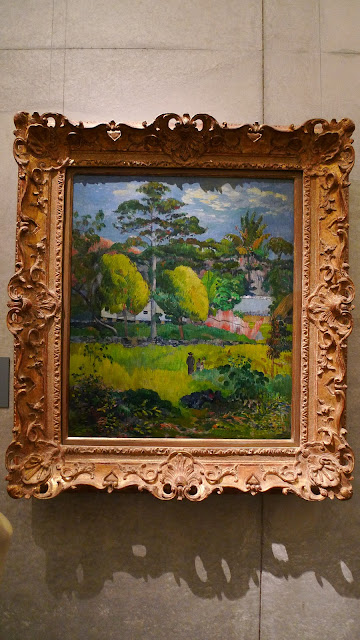After visiting Monet's house and garden in Giverny, where we have gotten an idea of Monet's surroundings, a visit to the Musée L'Orangerie is the next thing to do. This is where his last series of paintings are displayed, the ones that were inspired by the scenic water-lily pond.

Originally designed as a winter greenhouse for the orange trees at the Jardin des Tuileries (Tuileries Garden) by Firmin Bourgeois and completed by Ludovico Visconti in 1852, the Musée L'Orangerie was renovated by architect Camille Lefevre - in consultation with Monet, as to how to present his paintings. It opened it's doors as a museum in May, 1927, about five months after the death of Monet. It closed in 1999 to undergo some redesigning and restructuring.
After some delay, it was in 2006 that the Musée L'Orangerie was reopened after six years of renovation work, which was estimated at a budget of twenty five million euros. With a reconfiguration of the exhibition rooms, Monet's eight masterpieces were now the focal point in two elliptical rooms on the upper floor, solely dedicated to his series of water-lily paintings, Les Nymphéas, measuring two meters high and 100 meters long, in total.

The rooms were especially designed to bring in the light, to enhance the light elements - the different hours of the day as captured by Monet in his paintings. This was achieved by painting the rooms in ivory-white and with the installation of a circular skylight.
When you come to see Monet's masterpieces, there are cushioned, long, curved benches where you could sit to study the master's works - looking at the different sections and taking note of certain elements, or you may prefer to get up close as you walk around. The students who come in groups, sit on the floor to listen to a lecture. There are also audio guides for rent, if you prefer to have your own guided tour.
A silent atmosphere is maintained, and this helps one to meditate and find himself in the artist's place, perhaps, as the scene was being painted.
"Morning"




"The Morning Light the Willows"





"Cloud Reflections on the Water Lily Pond"



"Green Highlights"



Details of the water lilies on the right-side corner of the mural
"Sunset"




Close up of the water lilies...the buds are closed.
A mural from two angles:


"The Two Willows"




In the late 1950s, the museum was gifted with the art collections of Jean Walter and Paul Guillaume. Now a part of the permanent exhibition, the works of famous artists - impressionist and post-impressionist - like Cézanne, Matisse, Utrillo, Picasso, Renoir and others can be viewed on the lower level .
"Arbes et Maison" (1885-1886)
Paul CÉZANNE 1839-1906
"Paysage"(1901)
Paul GAUGUIN 1848 - 1903
"Gabrielle et Jean" (1895-1896)
Pierre-Auguste RENOIR 1814 - 1919
Special exhibitions are scheduled at different times of the year.
A past exhibition was about Gino Severini, Futuriste et Neoclassique. This was the first retrospective presentation of Severini's works since they were last exhibited at the National Museum of Modern Art in Paris, in 1967. The major stages of Severini's career from 1905 to towards the end of the 1930s were showcased.
When you visit Paris in the spring and summer, or in the early fall, don't miss coming to this place if you are a Monet fan.
When you visit Paris in the spring and summer, or in the early fall, don't miss coming to this place if you are a Monet fan.
Jardin des Tuileries (facing Place de la Concorde)
1st arrondisement
Metro: Lines 1, 8, 12 Exit - Concorde
Bus Lines: 24, 42, 52, 72, 73, 84, 94 Stop - Concorde
Open daily, except on Tuesdays: May 1 to December 25, from 9 a.m. to 6 p.m.
Admissions: 7.50 euros for adults; 5.50 euros for students under 26 years of age
FREE admission on the first Sunday of the month






No comments:
Post a Comment